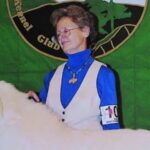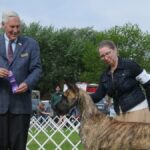Owner Handler Beginnings | Do you remember your beginning “in dogs?” Maybe you were born into the sport and you’ve been accompanying your mother and grandmother to shows for as long as you can remember. Or maybe your first time in the conformation ring occurred decades ago when it took 35 dogs to make a 3-point major. Perhaps you were showing your breed in the Miscellaneous Class and helped to navigate its journey to full recognition. Or it may be that you just got your start last year with your first show dog, and you’re still figuring out how to present your breed—or you’re trying to determine if your dog has what it takes to win. Whatever your current level of experience, it is always helpful to be reminded that no matter the particular details of your introduction, everyone who shows dogs begins at the beginning. Every owner handler starts from scratch.
The starting point for every exhibitor is positioned in the very same spot—at the beginning of each individual’s personal journey.
In the Beginning
At every dog show that’s ever been held, there has always been someone in the ring showing their dog for the very first time. It’s one of the sport’s more incredible aspects that newcomers compete in the very same arena as seasoned owner handlers and paid professionals. Even those second and third generation youngsters make their debut alongside exhibitors with years—decades—of experience. And each and every exhibitor’s first appearance in the ring is, essentially, the same. The sweaty palms and shaking knees are symptoms that affect all rookies, no matter their age or their accomplishments outside the conformation ring. Even retired executives who’ve managed thousands of people and millions of dollars can be reduced to a bundle of raw nerves when confronted with a willful puppy with little desire to stand for exam or gait in a straight line. The starting point for every exhibitor is positioned in the very same spot—at the beginning of each individual’s personal journey. And no matter the venue or the breed being shown (or the year in which that first entry was made), every owner handler has to start somewhere… and that somewhere is at the very beginning.
The Doggone Decades
Yet, for all the similarities that exhibitors share as part of their personal genesis in dogs, there’s one obvious distinction that determines the course of every owner handler’s journey and their ability to participate—and succeed—for years to come. Each and every exhibitor is strongly influenced by the period of time in which they began their involvement in the sport. Those who grew up in the ring during the 1940s and ‘50s have a direct connection to the all-breed judges of yore as well as to many of the breeders who helped to establish their breeds in this country. Exhibitors who entered the ring in ‘60s, ‘70s & ‘80s remember the days of stand-alone dog shows with big entries that were built largely with the hope of finishing championships rather than breaking records. And those exhibitors with ten, twenty or thirty years of experience might admit that their introduction to the world of purebred dogs began by responding to a classified ad in the Sunday paper or by peering through a pet shop window at the local shopping mall. Times do change, of course, and every novice exhibitor is a direct reflection of the (changing) times. For exhibitors who are today’s newly-minted owner handlers, the sport has likely been introduced through online searches or a post on social media.
Scratch That?
Among the many qualities that make being involved in the sport so rewarding are the sustained connections that are maintained to breeders, handlers, judges, venues, and dogs of the past. The very action of researching a pedigree or planning a litter helps to keep current exhibitors connected to those influential predecessors who worked tirelessly on behalf of their breeds and for the betterment of the sport. The only genuine difference between today’s rookie exhibitors and novices from the past is the period of time in which their introduction to the show ring was made. For those who have “been around” awhile, there’s often a temptation to cling to the way things used to be and to deride anything and everything that’s novel and new. For the owner handler who’s just starting out, the happenings of the 20th century can seem like ancient history, and the ability to instantly gather information on a smart phone can make the need to sit around after a show to “talk dogs” as unlikely as it can seem unnecessary. However, the most effective way for everyone to come together is to acknowledge our different approaches to participating in the sport and to respect the old ways even as we embrace unconventional new ideas. After all, there’s no need to throw away the things that have worked in the past, and there’s no cause to “scratch” every new idea just because it’s never been tried before.
The sport of dogs, and every recognized breed, will survive—and indeed, thrive—so long as today’s novice exhibitors seek guidance from experienced mentors, and veteran fanciers encourage newcomers by being open to new information and new technologies. Nobody in the sport functions in a vacuum. Everyone participates at the same events and everyone begins at the beginning.
The only genuine difference between
today’s rookie exhibitors and novices from the past is the period of time in which their introduction to the show ring was made.









